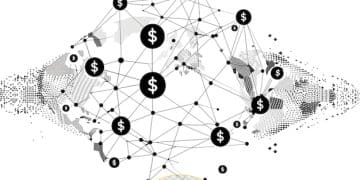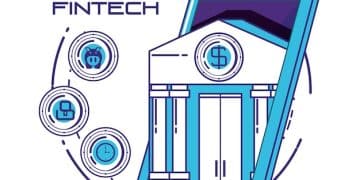Open Banking APIs: Redefining US Personal Finance by 2025

By 2025, open banking APIs are set to revolutionize personal finance management in the US by enabling seamless data sharing between financial institutions and third-party applications, fostering innovation, personalized services, and greater user control over financial data.
The landscape of personal finance in the US is on the cusp of a profound transformation, driven largely by the emergence of open banking APIs. This paradigm shift, actively shaping how consumers interact with their money, promises an era of unprecedented interconnectedness and personalization. But exactly how will open banking APIs redefine personal finance management in the US by 2025? This article dives into the mechanisms and implications of this financial evolution.
The Genesis of Open Banking: A Paradigm Shift in Financial Data
Open banking, at its core, represents a fundamental change in how financial institutions manage and share customer data. Historically, financial information has been siloed within individual banks, making it difficult for consumers to aggregate or utilize their data across multiple platforms. This proprietary model is gradually giving way to a more interconnected ecosystem, primarily through the implementation of Application Programming Interfaces (APIs).
APIs act as secure conduits, allowing different software applications to communicate and share data in a standardized way. In the context of open banking, these APIs empower customers to securely grant third-party providers (TPPs), such as fintech startups and other financial service companies, access to their financial data. This consent-driven data sharing is crucial, as it places the customer firmly in control of their own information. The US financial sector, while a relative latecomer compared to regions like Europe and the UK, is rapidly recognizing the transformative potential of this model.
Evolution from Screen Scraping to Secure APIs
Before the advent of standardized open banking APIs, many financial apps relied on “screen scraping” to access user data. This involved users providing their banking login credentials to a third-party app, which would then “scrape” data directly from the bank’s website. This method, fraught with security risks and often unreliable, lacked the robustness and security protocols that modern APIs offer. The transition to API-driven data exchange significantly enhances security, reliability, and user trust.
- Enhanced Security: APIs use token-based authentication, meaning users grant permissions without sharing their actual login credentials.
- Improved Reliability: Standardized APIs ensure consistent data flow and reduce error rates compared to screen scraping.
- Greater Control: Users can revoke access to their data at any time, providing superior granular control.
Regulatory Impetus and Industry Adoption
The push for open banking in the US is not solely market-driven; regulatory bodies are also playing a critical role. While not as prescriptive as the PSD2 directive in Europe, US regulators, including the CFPB (Consumer Financial Protection Bureau), are exploring ways to facilitate secure data sharing and promote competition. This regulatory support, coupled with a growing demand from consumers for more integrated financial experiences, is accelerating the adoption of open banking principles by traditional banks and innovative fintechs alike. Early adopters are already seeing the benefits, driving a competitive environment that encourages broader participation.
The foundational shift introduced by open banking APIs lays the groundwork for a financial ecosystem where data liquidity fuels innovation. This secure and consent-based data exchange is not just a technological upgrade; it’s a strategic move that promises to redefine the competitive landscape and elevate the consumer experience in personal finance management.
Personalized Financial Insights and Advice
One of the most significant impacts of open banking APIs will be the personalization of financial insights and advice. With customer consent, fintech apps will be able to aggregate data from multiple financial sources—checking accounts, savings, credit cards, investments, and even loans—to create a holistic view of an individual’s financial health. This comprehensive data set unlocks a new era of tailored guidance that was previously unattainable or required extensive manual effort from the user.
Imagine an application that not only tracks your spending but also analyzes your saving habits across different banks, suggests optimal budgeting strategies based on real-time income and expenditure, and even identifies opportunities to reduce fees or improve investment returns. Open banking APIs make this level of sophisticated financial analysis possible. The ability to pull data seamlessly from various institutions allows these platforms to offer truly bespoke recommendations, moving beyond generic advice to actionable insights specific to each user’s financial situation and goals.

Real-time Budgeting and Spending Analysis
Traditional budgeting often involves backward-looking analysis or manual data entry. Open banking APIs will enable real-time tracking of transactions from all linked accounts. This means users can see exactly where their money is going as it happens, not days or weeks later. Advanced algorithms can then categorize spending, identify recurring subscriptions, and flag unusual or excessive expenditures instantly.
- Instant Expense Categorization: Automates the classification of transactions for clear spending overview.
- Proactive Spending Alerts: Notifies users of potential budget overruns before they occur.
- Subscription Management: Identifies and helps manage recurring payments, preventing unwanted renewals.
Tailored Product Recommendations and Financial Planning
Beyond budgeting, open banking APIs will empower platforms to offer highly personalized product recommendations. If an app identifies that a user is paying high interest on a credit card, it could suggest lower-rate alternatives from competing banks. Similarly, if a user consistently demonstrates responsible financial behavior, the app could proactively offer investment opportunities or insurance products that align with their risk appetite and financial goals.
This goes beyond simple product suggestions; it facilitates more dynamic and responsive financial planning. As life events occur—a new job, marriage, buying a home—the integrated data allows financial planning tools to adjust strategies in real-time, helping users stay on track with their long-term objectives. The synergy between data access and analytical capabilities is rapidly converging, providing an unparalleled advantage to consumers seeking to optimize their financial well-being.
The transformation spurred by open banking APIs signifies a shift from reactive to proactive financial management. Instead of users laboriously gathering information, the insights come to them, curated and contextualized. This level of personalized engagement is set to profoundly alter how individuals approach and manage their personal finances, making financial literacy and effective money management more accessible and intuitive than ever before.
Enhanced User Experience and Seamless Integrations
The impact of open banking APIs extends well beyond personalized insights, fundamentally redefining the user experience in personal finance management. The core promise is a future where financial services are no longer confined to disparate applications and websites, but instead seamlessly integrated into daily life. This means less friction, fewer passwords, and a more intuitive interaction with one’s money.
Think about the current hassles: logging into multiple bank portals, downloading statements, or manually uploading data to budgeting apps. Open banking eliminates much of this cumbersome process. Instead, users grant permission once, and their preferred financial management tools automatically populate with up-to-date information. This seamless data flow not only saves time but also significantly reduces the cognitive load associated with managing complex financial lives.
Consolidated Financial Dashboards
One of the immediate benefits will be the proliferation of sophisticated consolidated financial dashboards. These platforms, powered by open banking APIs, will allow users to view all their accounts—checking, savings, credit cards, mortgages, investments, and even alternative assets—in one unified interface. This single pane of glass offers an unparalleled overview, simplifying financial tracking and decision-making.
- Comprehensive Overview: All financial accounts accessible from a single app or platform.
- Simplified Asset Tracking: Easily monitor net worth and asset allocation across institutions.
- Reduced Administrative Burden: Less time spent switching between multiple banking applications.
Streamlined Account Opening and Loan Applications
Beyond daily management, open banking APIs promise to revolutionize traditionally tedious processes like opening new bank accounts or applying for loans. Instead of manually inputting financial history or submitting endless paperwork, users, with their consent, could allow lenders or new financial institutions to securely access their verified financial data directly. This can significantly speed up approval processes, reduce fraud, and improve the accuracy of financial assessments.
This streamlining not only benefits consumers through faster service but also provides financial institutions with more comprehensive and reliable data for underwriting and risk assessment. The efficiency gains are substantial for all parties involved, making financial products more accessible and the application process less daunting. The focus shifts to value-added services rather than data collection.
Furthermore, the improved user experience fosters greater engagement with financial tools. When managing money becomes easier and more intuitive, people are more likely to actively participate in their financial health. This heightened engagement, driven by the smooth integrations enabled by open banking APIs, is a cornerstone of the future of personal finance in the US.
Innovation and Competition in the Fintech Landscape
Perhaps one of the most exciting aspects of open banking APIs is their potential to ignite a new wave of innovation and competition within the US fintech landscape. By democratizing access to financial data (with user consent), open banking lowers the barriers to entry for new players, allowing startups and established companies alike to develop novel solutions that challenge traditional banking models.
Historically, the high cost and complexity of integrating with legacy banking systems have stifled innovation. Only well-funded companies could afford the extensive development work required. Open banking APIs, however, provide a standardized, secure, and developer-friendly way to connect. This fosters an environment where ingenuity thrives, leading to a wider array of specialized and niche financial products designed to meet specific consumer needs.

Emergence of Specialized Fintech Services
The availability of robust APIs will lead to a Cambrian explosion of specialized fintech services. We can expect to see apps designed for specific demographics, such as gig economy workers in need of irregular income management tools, or young professionals looking for hyper-personalized investment advice. These niche solutions, powered by granular financial data, can offer unparalleled value that mass-market offerings often miss.
- Hyper-Personalized Investment Advisors: Algorithms that tailor investment strategies based on detailed spending habits and risk profiles.
- Automated Debt Management: Tools that actively seek out opportunities to optimize debt repayment across different lenders.
- Financial Wellness Platforms: Apps integrating health, wellness, and financial goals for holistic life planning.
Increased Competition Benefits Consumers
The increased competition fostered by open banking is a definite win for consumers. When more players enter the market, driven by the ability to build on open data, traditional banks are pushed to innovate and improve their own offerings. This can lead to:
- Lower Fees: As services become more competitive, providers will be pressured to reduce costs.
- Better Interest Rates: Banks and lenders will compete more aggressively for deposits and loan customers.
- Superior Customer Service: Companies will differentiate themselves not just on price, but on the quality of their user experience and support.
This dynamic environment means that stagnant or inefficient financial services will be challenged by nimble, tech-forward alternatives. The overall effect will be a more vibrant, responsive, and ultimately, more consumer-centric financial services industry in the US. By 2025, the impact of this innovation will be palpable, offering consumers more choice and better value across the entire spectrum of personal finance.
Addressing Security, Privacy, and Trust Concerns
While the benefits of open banking APIs are undeniable, their widespread adoption and impact on personal finance management in the US by 2025 hinge critically on how effectively security, privacy, and trust concerns are addressed. The idea of sharing sensitive financial data, even with consent, naturally raises questions among consumers. Building and maintaining trust is paramount for widespread acceptance.
The open banking framework is designed with security as a central pillar. Unlike less secure methods, APIs enforce strict security protocols, including strong encryption, multi-factor authentication, and robust authorization mechanisms. These technical safeguards are essential, but equally important is clear communication and transparent practices from both financial institutions and third-party providers (TPPs).
Robust Security Protocols and Data Encryption
Open banking relies on state-of-the-art security measures to protect user data in transit and at rest. This includes:
- End-to-End Encryption: Ensures that data exchanged between parties is unreadable to unauthorized individuals.
- API Security Standards: Adherence to industry-recognized standards for API authentication and authorization.
- Regular Security Audits: Ongoing assessments to identify and mitigate potential vulnerabilities in the system.
Financial institutions and fintech companies investing in open banking APIs must prioritize these security features, continuously updating them to counteract evolving cyber threats. The integrity of the entire ecosystem depends on the weakest link, necessitating a collective commitment to robust cybersecurity hygiene.
User Consent and Data Privacy Controls
The “open” in open banking is fundamentally about user control. Consumers must have complete transparency and granular control over which data is shared, with whom, and for how long. This means:
- Clear Consent Mechanisms: Easy-to-understand interfaces for granting and revoking data access.
- Granular Data Permissions: Users should be able to choose specific types of data to share (e.g., only transaction history, not personal details).
- Data Breach Notification: Clear protocols for notifying users in the event of a security incident.
Regulatory frameworks in the US are evolving to ensure these privacy controls are mandated and enforceable. The CFPB’s focus on consumer data rights will likely lead to clearer guidelines and protections. For TPPs, demonstrating a commitment to responsible data handling, beyond just compliance, will be a key differentiator in earning consumer trust. Ultimately, the success of open banking by 2025 will be measured not only by its technological sophistication but by the confidence it instills in the public.
Challenges and Roadblocks for US Adoption
Despite the immense potential, the journey to full open banking API adoption and its transformative impact on personal finance management in the US by 2025 is not without its challenges. The US financial ecosystem is notoriously complex, fragmented, and regulated by multiple bodies at both federal and state levels. These factors present unique roadblocks that must be navigated for open banking aspirations to fully materialize.
One of the primary hurdles is the absence of a single, overarching federal mandate for open banking, similar to PSD2 in Europe. While the CFPB is actively exploring consumer data rights under Section 1033 of the Dodd-Frank Act, the lack of a unified regulatory framework means that adoption is often driven by market forces and voluntary cooperation among diverse financial institutions, which can lead to inconsistencies and slower progress.
Regulatory Fragmentation and Standardization
The layered regulatory environment in the US, with different rules for banks, credit unions, and non-bank financial institutions, complicates the creation of universal open banking standards. Without a common set of guidelines for data exchange, security, and consent, implementing interoperable APIs across the entire financial spectrum becomes a significant technical and legal challenge.
- Diverse Compliance Requirements: Financial entities must navigate a patchwork of regulations, impacting uniform API deployment.
- Lack of Industry-Wide Standards: Absence of mandatory API specifications can lead to varying data quality and access across providers.
- Slower Market Adoption: Legal and operational complexities can deter smaller institutions from investing in open banking technologies.
Incumbent Resistance and Legacy Systems
Many large, traditional banks in the US operate with complex legacy IT systems that are not easily adaptable to the API-first architecture required for open banking. Modernizing these systems represents a significant investment in time, capital, and resources. Some incumbent institutions may also be reluctant to facilitate data sharing, fearing increased competition or a loss of direct customer relationships. This inherent resistance can slow down the pace of API development and adoption across the industry.
Overcoming these technical and organizational inertia challenges requires sustained effort and a clear business case for collaboration. While some larger banks are proactively engaging with open banking initiatives, broader participation is essential for the ecosystem to thrive. The next few years will be critical in determining whether these challenges can be effectively addressed to unlock the full potential of open banking APIs for US consumers.
The Future: Beyond 2025 and the Open Finance Horizon
While the focus is on how open banking APIs will redefine personal finance management in the US by 2025, it’s crucial to recognize that 2025 is merely a significant milestone, not the ultimate destination. The trajectory initiated by open banking is set to evolve into a broader concept known as “open finance,” promising an even more integrated and comprehensive financial ecosystem. This next phase will extend the principles of data sharing beyond traditional banking products to encompass a much wider array of financial data.
Open finance envisions a world where consumers can securely share data not just from their bank accounts and credit cards, but also from investments, pensions, insurance policies, mortgages, utility bills, and even payroll data. This expansive view of financial data will unlock unprecedented opportunities for personalized services, holistic financial planning, and a truly unified view of an individual’s financial life.
Integration with Non-Banking Financial Services
Post-2025, open banking APIs will likely mature into generalized open finance APIs. This means seamless connections with:
- Insurance Providers: Allowing for dynamic premium adjustments based on real-time behavior indicators linked by consent.
- Investment Platforms: Offering hyper-tailored advice across all asset classes, including alternative investments.
- Pension and Retirement Accounts: Providing a unified view of long-term financial health and retirement readiness.
This level of integration will enable a new generation of super-apps that act as comprehensive financial operating systems for consumers, offering proactive advice and automated management across every aspect of their financial lives, from daily spending to long-term wealth building.
Regulatory Evolution Towards Data Portability
The regulatory landscape is expected to continue its evolution, pushing for greater data portability and consumer control across all financial sectors. The US may see more formalized regulations that mandate data sharing beyond basic banking, ensuring that consumers truly “own” their financial data and can direct its use as they see fit. This will empower individuals to switch providers more easily, fostering a more competitive and consumer-friendly market.
The expansion from open banking to open finance represents a commitment to placing the consumer at the center of the financial ecosystem. By 2025, the groundwork laid by open banking APIs will already be radically reshaping personal finance. Beyond that, the open finance horizon promises an even more frictionless, personalized, and efficient financial future, where managing money becomes an intuitive and empowering experience.
| Key Aspect | Brief Impact |
|---|---|
| 📊 Personalized Insights | Customized budgeting, spending analysis, and financial advice based on aggregated data. |
| ✨ Enhanced User Experience | Consolidated financial dashboards and streamlined processes like account opening. |
| 🚀 Innovation & Competition | Democratized data access fosters new fintech services and drives market competition. |
| 🔒 Security & Trust | Focus on robust protocols and user-centric privacy controls critical for adoption. |
Frequently Asked Questions about Open Banking in the US
Open banking is a financial services practice that allows third-party financial service providers to access consumer banking data with explicit customer consent. It works through Application Programming Interfaces (APIs) that securely connect banks with fintech apps, enabling seamless and safe data exchange for various personalized financial services.
By 2025, open banking will primarily offer personalized financial insights, real-time budgeting, and consolidated views of all financial accounts. It will also foster increased competition among financial providers, leading to better products, lower fees, and streamlined processes for US consumers, significantly enhancing overall financial wellness.
Open banking APIs are built with strong security measures, including encryption and token-based authentication, which are generally more secure than older methods like screen scraping. User consent is paramount, and consumers retain granular control over their data, being able to revoke access at any time. Regulatory oversight aims to further enhance these protections.
While the US lacks a unified federal mandate like Europe’s PSD2, the Consumer Financial Protection Bureau (CFPB) is actively exploring rules to facilitate consumer data rights and secure data sharing. This regulatory push, though fragmented, is vital for establishing trust, standardizing practices, and accelerating the adoption of open banking principles across diverse financial entities.
Open banking specifically focuses on sharing data from traditional bank accounts, credit cards, and payments. Open finance is a broader concept that extends data sharing to a wider array of financial data, including investments, pensions, insurance, mortgages, and more, aiming for a truly holistic and integrated view of a consumer’s entire financial life.
Conclusion
The journey towards a fully integrated and consumer-centric financial landscape in the US is well underway, with open banking APIs serving as its primary catalyst. By 2025, these powerful tools are poised to transform personal finance management from a fragmented, often cumbersome task into a seamless, highly personalized experience. From offering granular, real-time insights to fostering an explosion of innovative fintech services, open banking promises to empower individuals with greater control and understanding of their financial well-being. While challenges related to regulation and legacy systems persist, the undeniable benefits in security, user experience, and market competition suggest that a more efficient, transparent, and responsive financial future is within reach, fundamentally redefining how we interact with our money.





